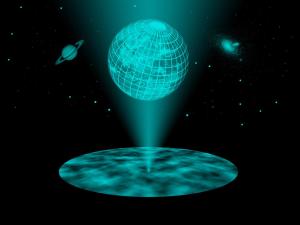Blog
The Universe is Still
Not a Hologram
29 April 2015
 TU Wien
TU WienTis the season for claims that the universe is a hologram again. Just to be clear, there’s no observational evidence that the universe is a hologram, and the latest research driving the sensational headlines doesn’t claim that there is. But there is some interesting theoretical work regarding the holographic principle that is worth discussing.
The holographic principle argues that the information contained within a region of space can be determined by the information at the surface that contains it. For example, imagine a road 10 miles long that is “contained” by a start line and a finish line. Suppose the speed limit on this road is 60 mph, and I want to determine if a car has been speeding. One way I could do this is to watch a car the whole length of the road, measuring its speed the whole time. But another way is to simply measure when a car crosses the start line and finish line. At a speed of 60 mph, a car travels a mile a minute, so if the time between start and finish is less than 10 minutes, I know the car was speeding. Mathematically, the space can be represented as a hologram of the surface that contains it. Unfortunately the term hologram invokes images of virtual reality and the idea that we’re living in the Matrix, which couldn’t be farther from the truth.
As a theoretical tool the holographic principle is useful because it is easier to do some calculations on a boundary than it is on the enclosed volume. One of the most popular uses of the principle is in string theory, through something known as the AdS/CFT correspondence, which uses the holographic principle to connect the strings of particle physics string theory with the geometry of general relativity. The AdS stands for anti-deSitter space, which is a non-flat model universe. Anti-deSitter space can’t be used as a model for the physical universe, because we know observationally that the universe is extremely flat.
It would be nice if there were a similar holographic correspondence for a flat universe model, but proving one has been difficult. Now a new paper has shown that the holographic principle can apply to flat space models, at least in some cases.1 The team looked at an aspect of quantum theory known as entanglement. If two objects such as electrons are entangled, they can be described in quantum theory as a single entity. Entanglement is one of the more strange aspects of quantum theory, and leads to some strange predictions about the universe, but has been experimentally validated. What the team found was that a calculation in standard quantum theory of a particular entanglement property dealing with entropy gave the same result when done using a holographic version. In other words, the standard and holographic versions are mathematically equivalent. They did these calculations in a model universe that’s flat, which demonstrates the holographic principle can work in flat space.
This is not a general proof, and it doesn’t show that the holographic principle does work for a flat universe like ours, only that it might when it comes to quantum systems. There’s a lot more work to do before anyone can say with certainty that there is a flat space version of AdS/CFT correspondence. And even then it won’t mean the universe is a hologram.
Bagchi, Arjun, et al. “Entanglement entropy in Galilean conformal field theories and flat holography.” Physical Review Letters 114.11 (2015): 111602. ↩︎